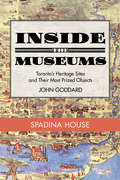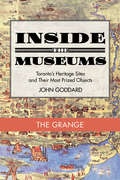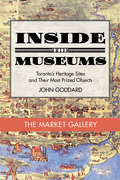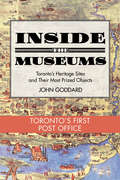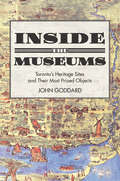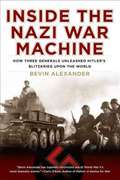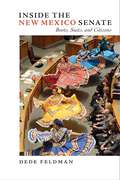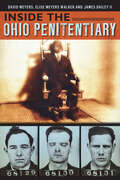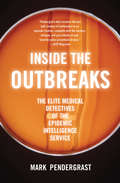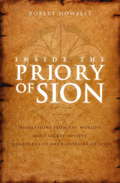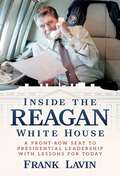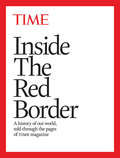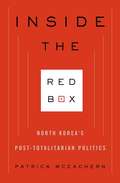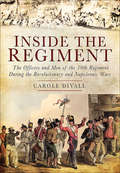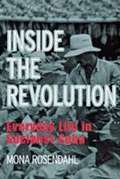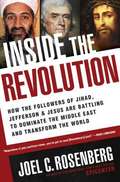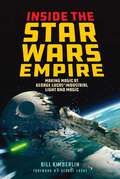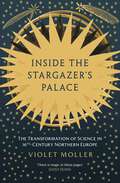- Table View
- List View
Inside the Museum — Spadina House
by John GoddardInside the Museums views Toronto’s heritage museums for the first time as a single community — linked by events, personalities, and function. In this special excerpt we visit Spadina House on Davenport Hill, less renowned than its ornate but much later neighbour, Casa Loma, and first erected by landowner and politician Dr. William Baldwin in 1818. John Goddard takes us on a detailed tour, providing fascinating historical background and insight.
Inside the Museum — The Grange
by John GoddardInside the Museums views Toronto’s heritage museums for the first time as a single community — linked by events, personalities, and function. In this special excerpt we visit the well-known Grange at 317 Dundas Street West, near the Art Gallery of Ontario. More than any other house in Toronto, The Grange, built in 1817, testifies to the years when a tiny, colonial elite connected by blood and marriage — the Family Compact — dominated the government and judiciary. The Grange was home to the Boultons. On the Family Compact tree compiled by critic William Lyon Mackenzie, patriarch D’Arcy Boulton Sr. ranked No. 1. John Goddard takes us on a detailed tour of the house, providing fascinating historical background and insight.
Inside the Museum — The Market Gallery
by John GoddardInside the Museums views Toronto’s heritage museums for the first time as a single community — linked by events, personalities, and function. In this special excerpt we visit The Market Gallery at 95 Front Street East — the upper floor of the famous St. Lawrence Market. Walk into the market’s interior and look back carefully, and you clearly see an earlier building. It is the remains of Toronto’s first purpose-built City Hall. John Goddard takes us on a detailed tour, providing fascinating historical background and insight.
Inside the Museum — Toronto's First Post Office
by John GoddardInside the Museums views Toronto’s heritage museums for the first time as a single community — linked by events, personalities, and function. In this special excerpt we visit Toronto’s first post office at 260 Adelaide Street East, a handsome red-brick building still flying the Union Jack, and built in 1834. John Goddard takes us on a detailed tour of the house, providing fascinating historical background and insight.
Inside the Museums: Toronto's Heritage Sites and their Most Prized Objects
by John GoddardHeritage Toronto Book Award — Shortlisted, Non-Fiction Book Illuminates Toronto’s early history through its small heritage museums. A portrait of William Lyon Mackenzie stares from a mural at Queen subway station, his face as round and orange as a wheel of cheese. He served as Toronto’s first mayor, led the Upper Canada Rebellion of 1837, and was grandfather to William Lyon Mackenzie King, Canada’s tenth prime minister, whose own orange-pink visage graces the Canadian fifty-dollar bill. Three blocks from the station, Mackenzie died in the upstairs bedroom of a house now open as a heritage museum, part of a network of such homes and sites from early Toronto. Inside the Museums tells their stories. It explains why Eliza Gibson risked her life to save a clock, reveals the appalling instructions that Robert Baldwin left in his will, and examines how the career of postmaster James Scott Howard shattered on the most baseless of innuendos at one of the most highly charged moments in the city’s history.
Inside the National Security Council: The True Story of the Making and Unmaking of Reagan's Foreign Policy
by Constantine C. MengesThis fascinating look at the National Security Council under the Reagan administration is well worth it. Menges examines political in-fighting and the convolutions of Reagan's foreign policy. Should be required reading for all students of foreign affairs and political science.
Inside the Nazi War Machine: How Three Generals Unleashed Hitler's Blitzkrieg Upon the World
by Bevin AlexanderIn 1940, as Hitler plotted to conquer Europe, only one nation posed a serious threat to the Third Reich's domination: France. The German command was wary of taking on the most powerful armed force on the continent. But three low-ranking generals-Eric von Manstein, Heinz Guderian, and Erwin Rommel-were about to change the face of modern warfare.By grouping tanks into juggernauts to slam through enemy lines, the blitzkrieg was born. With this aggressive, single-minded plan, the Nazis bypassed the supposedly impenetrable Maginot Line, charged into the heart of France, and alerted the world that the deadly might of Germany could no longer be ignored.
Inside the New Mexico Senate: Boots, Suits, and Citizens
by Dede Feldman&“Completely honest and highly informative. To look at a legislative body is to observe democracy in the raw—with all its diverse characters and influences and its many conflicts, compromises, and achievements. Dede Feldman, a first-rate observer and chronicler, shows us the insides of the New Mexico State Senate.&”—Fred Harris, former U.S. Senator and professor emeritus of political science, University of New MexicoElected to New Mexico&’s state senate in 1996, Dede Feldman faced the challenges that confront state legislators around the country along with some that are uniquely New Mexican. In this forthright account of the workings of New Mexico&’s legislature, she reveals how the work of governing is actually accomplished.In New Mexico&’s part-time citizen legislature, Spanish may be spoken in the halls of the capitol as often as English, and Native American issues are often pivotal. But each year the Land of Enchantment&’s legislators, like those in other states, must balance revenues and expenditures, tangle with lobbyists, and struggle with redistricting and campaign finance reform. State legislatures&’ approaches to air pollution, drunk driving, and chronic disease, Feldman&’s book reveals, find their way into national law after they&’ve been road tested on the highways of various states.
Inside the Ohio Penetentiary (Landmarks)
by David Meyers Elise Meyers Walker James Dailey IIExplore one of history&’s most notorious maximum-security prisons through these tales of mayhem and madness. As &“animal factories&” go, the Ohio Penitentiary was one of the worst. For 150 years, it housed some of the most dangerous criminals in the United States, including murderers, madmen and mobsters. Peer in on America&’s first vampire, accused of sucking his victims&’ blood five years before Bram Stoker&’s fictional villain was even born; peek into the cage of the original Prison Demon; and witness the daring escape of John Hunt Morgan&’s band of Confederate prisoners.
Inside the Outbreaks: The Elite Medical Detectives of the Epidemic Intelligence Service
by Mark PendergrastThe &“fascinating&” story of the CDC&’s intrepid investigators, who travel the world to protect us from deadly pathogens (Chicago Tribune). Since its founding in 1951, the Epidemic Intelligence Service has waged war on every imaginable ailment. When an epidemic hits, the EIS will be there to crack the case, however mysterious or deadly, saving countless lives in the process. Over the years they have successfully battled polio, cholera, and smallpox, to name a few, and in recent years have turned to the epidemics killing us now—smoking, obesity, and gun violence among them. The successful EIS model has spread internationally: former EIS officers on the staff of the Centers for Disease Control have helped to establish nearly thirty similar programs around the world. EIS veterans have gone on to become leaders in the world of public health in organizations such as the World Health Organization. Inside the Outbreaks takes readers on a riveting journey through the history of this remarkable organization, following Epidemic Intelligence Service officers on their globetrotting quest to eliminate the most lethal and widespread threats to the world&’s health.
Inside the President's Team: Family, Service, and the Gerald Ford Presidency
by Bob BarrettAn eye-opening and exceptional view of the Ford presidency by one of his closest and most-trusted advisors. Except for his wife Betty, no one was closer to Gerald Ford during his presidency than Bob Barrett. Bob carried the &“nuclear football&”—the American nuclear codes—and could not let Ford out of his sight. This nerve-wracking job led to a deep friendship with the First Family and gave Bob an unparalleled view of Ford&’s historic and unusual presidency. In his memoir, Inside the President&’s Team, Bob takes readers into the White House and the Ford home to show the administration and the couple as few others could see them. Bob gives new insights into why Ford decided to pardon Nixon and how he responded to criticism of it; how Ford chose his own vice president (and another for his run in 1976); and what he did with potentially difficult members of the former administration, such as Al Haig and the now-infamous Michael Flynn. Bob provides a front-row view of Ford&’s meeting with Leonid Brezhnev in Russia during their famous summit on arms control, and he shows how abandoning our ally South Vietnam put a greater strain on Ford than deciding whether to pardon his predecessor. Bob reveals what happened during the two assassination attempts and reveals the flawed inner workings of the 1976 campaign. Meanwhile, he became so close to the family that he took part in Betty Ford&’s intervention and recalls scenes that show Ford to be, as Bob describes him, &“the most decent, honorable, trustworthy person I ever met.&” Ford's legacy as a reconciler and a healer of a deeply divided America during a time of strife comes alive in Inside the President's Team, and it is a celebration of the impact of living a life of service.
Inside the Priory of Sion
by Robert HowellsFor the first time, inside sources from the reclusive Priory of Sion--thrust into the limelight by Dan Brown's bestselling The Da Vinci Code--share their best-kept secrets, including proof of the marriage of Jesus and Mary Magdelene. The reason is as sensational as the secrets themselves: the apocalypse foretold in the Book of Revelation, culminating in the emergence of a savior sprung from the bloodline of Christ. Join Robert Howells as he traces the clues to this cataclysm in tombs, temples, churches, manuscripts, and paintings to give readers the truth they need to face the Second Coming without fear.
Inside the Radicalized Mind: The Neuropolitics of Terrorism and Violent Extremism (Elements in Experimental Political Science)
by Tiffiany HowardThis Element aims to better understand the role of the internet in the radicalization process, focusing on how online factors contribute to self-radicalization. Specifically, it examines the neurocognitive process of online radicalization by analyzing the impact of terrorist and extremist propaganda videos on individuals' cognitive empathy using electroencephalography (EEG). Ultimately, this research aims to provide a more comprehensive understanding of online radicalization and the psychological effects of exposure to extremist content on the internet.
Inside the Reagan White House: A Front-Row Seat to Presidential Leadership with Lessons for Today
by Frank LavinAn inside look at the most successful president of modern times.What makes a good White House memoir? The right mix of personal stories, insight on the president, discussion of policy and historical events, and crazy, colorful anecdotes that capture the reader&’s attention. Inside the Reagan White House has all this—plus a vivid take on the Reagan assassination attempt, , Gorbachev and the Reykjavik summit, Ollie North and the Contras, , the 1988 Bush-Dukakis contest—and other critical moments of that era. Original insight on Ronald Reagan, as well as discussions of cabinet members and others, are interspersed with personal anecdotes, off-hand comments, and unique family details that historians and general readers will love. On the colorful side, the action moves from movie stars to Soviet spies to (literal) knife fights, neo-Nazis, plain old Nazis, intimate affairs, fights on planes, and con men chased by INTERPOL. And at the heart of the story are the thousands of dedicated, patriotic Americans who helped Ronald Reagan as he worked to push back against the Soviet Union, promote democracy, improve trade, lower taxes, and reduce the size and scope of government.
Inside the Red Border: A History of Our World Told Through the Pages of TIME
by Editors of Time MagazineAs a unique window on the world, the cover of TIME is the most celebrated and coveted showcase in print journalism. People who have had their faces on TIME's cover--Presidents and movie stars, corporate titans and sporting legends--consider it one of the highest forms of recognition. To TIME's worldwide audience of nearly 50 million, the cover declares, "Dear reader, we've decided this is important for you to know." In Inside the Red Border, thousands of weekly statements of who and what matters are telescoped into a single, never-before-assembled volume that traces our modern history through TIME's iconic artwork and cover stories that became an influential part of the news they were covering. TIME's cover, "has never lost its power to immediately send the signal...that in some way history is being made before our eyes." That power was reasserted as recently at May 2012 by TIME's instantly famous cover, "Are You Mom Enough?" In celebration of 90 years of TIME, Inside the Red Border features interviews with former and current magazine editors to offer insight and a revealing look at how TIME chooses to cover historic moments within its iconic red border.
Inside the Red Box: North Korea's Post-totalitarian Politics
by Patrick MceachernTraditional political models fail to account for North Korea's institutional politics, making the country's actions seem surprising or confusing when, in fact, they often conform to the regime's own logic. Drawing on recent primary materials, including North Korean speeches, commentaries, and articles, Patrick McEachern, a specialist on North Korean affairs, reveals how the state's political institutions debate policy and inform and execute strategic-level decisions. Many scholars dismiss Kim Jong-Il's regime as a "one-man dictatorship" and call him the "last totalitarian leader," but McEachern identifies three major institutions that help maintain regime continuity: the cabinet, the military, and the party. These groups hold different institutional policy platforms and debate high-level policy options both before and after Kim and his senior leadership make their final call. This method of rule may challenge expectations, but North Korea does not follow a classically totalitarian, personalistic, or corporatist model. Rather than being monolithic, McEachern argues, the regime, emerging from the crises of the 1990s, rules differently today than it did under Kim's father, Kim Il Sung. The son is less powerful and pits institutions against one another in a strategy of divide and rule. His leadership is fundamentally different: it is "post-totalitarian." Authority may be centralized, but power remains diffuse. McEachern maps this process in great detail, supplying vital perspective on North Korea's reactive policy choices, which continue to bewilder the West., reviewing a previous edition or volume
Inside the Red Box: North Korea's Post-totalitarian Politics (Contemporary Asia in the World)
by Patrick McEachernNorth Korea's institutional politics defy traditional political models, making the country's actions seem surprising or confusing when, in fact, they often conform to the regime's own logic. Drawing on recent materials, such as North Korean speeches, commentaries, and articles, Patrick McEachern, a specialist on North Korean affairs, reveals how the state's political institutions debate policy and inform and execute strategic-level decisions.Many scholars dismiss Kim Jong-Il's regime as a "one-man dictatorship," calling him the "last totalitarian leader," but McEachern identifies three major institutions that help maintain regime continuity: the cabinet, the military, and the party. These groups hold different institutional policy platforms and debate high-level policy options both before and after Kim and his senior leadership make their final call. This method of rule may challenge expectations, but North Korea does not follow a classically totalitarian, personalistic, or corporatist model. Rather than being monolithic, McEachern argues, the regime, emerging from the crises of the 1990s, rules differently today than it did under Kim's father, Kim Il Sung. The son is less powerful and pits institutions against one another in a strategy of divide and rule. His leadership is fundamentally different: it is "post-totalitarian." Authority may be centralized, but power remains diffuse. McEachern maps this process in great detail, supplying vital perspective on North Korea's reactive policy choices, which continue to bewilder the West.
Inside the Red Mansion: On the Trail of China's Most Wanted Man
by Oliver AugustA journalist meets fascinating characters while seeking out a fugitive gangster in the Chinese underworld.The notorious gangster Lai Changxing started out as an illiterate farmer, but in the tumult of China’s burgeoning economy, he seized the opportunity to remake himself as a bandit king. A newly minted billionaire of outsized personality and even greater appetites, he was a living legend who eventually ran afoul of authorities. The journalist Oliver August set out to find the fugitive Lai. On his quest he encountered a highly entertaining series of criminals and oddball entrepreneurs—and acquired unique insight into the paradoxes of modern China. Part crime caper, part travelogue, part trenchant cultural analysis, August’s page-turning account captures China’s giddy vibe and its darker vulnerabilities.Praise for Inside the Red Mansion“A year before “Inside the Red Mansion” was due to be published, a handler from the Chinese Foreign Ministry told August that he had enjoyed the book. You needn’t be a spy to agree.” —Janet Maslin, New York Times“A harrowing, super-detailed story of a China exploding with runaway growth yet still trapped in the past and ruled by the ethos of tufei—the classical Mandarin word for bandit . . . . This must-read, can’t-put-it down tale shows the China only hinted at on the evening news—a place of outsized egos, over-the-top commercial development and shadowy, tradition-bound authoritarian rule.” —Publishers Weekly
Inside the Regiment: The Officers and Men of the 30th Regiment During the Revolutionary and Napoleonic Wars
by Carole DivallIn this companion volume to her pioneering study Redcoats Against Napoleon, Carole Divall tells the fascinating inside story of a typical infantry regiment during the Revolutionary and Napoleonic wars. Rather than focusing on the history of the 30th Regiment of the Line in action and on campaign, she explores its organization, traditions and hierarchy, its personnel, and the ethos that held it together. Using primary source material, in particular surviving regimental records, War Office documents, letters and journals, Divall reconstructs the life of the 30th Foot – and the lives of the men who served in it – during a critical period in Europes military history.
Inside the Revolution: Everyday Life in Socialist Cuba
by Mona RosendahlInside the Revolution offers a rare, close view of how socialist ideology translates into everyday experience in one Cuban municipality. Mona Rosendahl draws on eighteen months of fieldwork, in a municipality she calls by the fictional name Palmera, to present a vivid account of the lives and thoughts of residents, many of whom have lived inside the revolution for more than thirty-five years.
Inside the Revolution: How the Followers of Jihad, Jefferson & Jesus Are Battling to Dominate the Middle East and Transform the World
by Joel C. RosenbergInside the Revolution takes you inside the winner-take-all battle for the hearts, minds, and souls of the people of the Middle East. It includes never-before-seen profiles of the Radicals, the Reformers and the Revivalists. It explains the implications of each movement and the importance of each leader, not only through the lenses of politics and economics but through the third lens of Scripture as well. Today, wars and revolutions define the modern Middle East, and many believe the worst is yet to come. How real and serious is the threat of Radical Islam to American national security eight years after 9/11? Are there any Muslim leaders who oppose the violence of the Radicals--and is there any hope that such leaders will come to power in key countries in the Middle East? What is God doing in the Middle East--and is there any hope that Muslims will find faith in Jesus Christ? How can we as Christians help strengthen our brothers and sisters who love Jesus in the Muslim world, and how can we reach out to Muslims here at home?
Inside the Royal Shakespeare Company: Creativity and the Institution
by Colin ChambersThis is the inside story of the Royal Shakespeare Company - a running historical critique of a major national institution and its location within British culture, as related by a writer who is uniquely placed to tell the tale. It describes what happened to a radical theatrical vision and explores British society's inability to sustain that vision. Spanning four decades and four artistic directors, Inside the Royal Shakespeare Company is a multi-layered chronicle that traces the company's history, offers investigation into its working methods, its repertoire, its people and its politics, and considers what the future holds for this bastion of high culture now in crisis. Inside the Royal Shakespeare Company is compelling reading for anyone who wishes to explore behind the scenes and consider the changing role of theatre in modern cultural life. It offers a timely analysis of the fight for creative expression within any artistic or cultural organisation, and a vital document of our times.
Inside the Star Wars Empire: A Memoir
by Bill KimberlinBill Kimberlin may refer to himself as &“one of those names on the endless list of credits at the close of blockbuster movies.&” In reality though, he&’s a true insider on some of the most celebrated and popular movies and franchises of the past century. Jurassic Park. Star Trek. Jumanji. Schindler&’s List. Saving Private Ryan. Even Forrest Gump. And perhaps most notably, Star Wars. Inside the Star Wars Empire is the very funny and insightful tell-all about the two decades Kimberlin spent as a department director at LucasFilm Industrial Light and Magic (ILM), the special effects studio founded by the legendary filmmaker George Lucas.
Inside the Stargazer's Palace: The Transformation of Science in 16th-Century Europe
by Violet MollerEnter the mysterious world of sixteenth-century science, where astronomers and alchemists shared laboratories.In 1543, Nicolaus Copernicus declared the earth revolved around the Sun, overturning centuries of scholastic presumption. A new age was coming into view – one guided by observation, technology and logic. But omens and elixirs did not disappear from the sixteenth-century laboratory. Charms and potions could still be found nestled between glistening brass instruments and leather-bound tomes. The line between the natural and supernatural remained porous, yet to be defined. From the icy Danish observatory of Tycho Brahe, to the smoky, sulphur-stained workshop of John Dee, Violet Moller tours the intellectual heart of early European science. Exploring its rich, multidisciplinary culture, Inside the Stargazer&’s Palace reveals a dazzling forgotten world, where all knowledge, no matter how arcane, could be pursued in good faith.
Inside the Stargazer's Palace: The Transformation of Science in 16th-Century Northern Europe
by Violet MollerEnter the mysterious world of sixteenth-century science, where astronomers and alchemists shared laboratories... 'There is magic in these pages.' Daisy Dunn, author of The Missing Thread In 1543, Nicolaus Copernicus declared the earth revolved around the Sun, overturning centuries of scholastic presumption. A new age was coming into view – one guided by observation, technology and logic. But omens and elixirs did not disappear from the sixteenth-century laboratory. Charms and potions could still be found nestled between glistening brass instruments and leather-bound tomes. The line between the natural and supernatural remained porous, yet to be defined. From the icy Danish observatory of Tycho Brahe, to the smoky, sulphur-stained workshop of John Dee, Violet Moller tours the intellectual heart of early European science. Exploring its rich, multidisciplinary culture, Inside the Stargazer&’s Palace reveals a dazzling forgotten world, where all knowledge, no matter how arcane, could be pursued in good faith. *** 'In this fascinating study of the early scientific revolution, when experimental thought was beginning to emerge from Medieval scholasticism, Violet Moller brings to life the trailblazers of this new age.' Paul Strathern, author of The Other Renaissance 'Inside the Stargazer's Palace plunges us into an irresistible network of touchy scientists, unpredictable patrons and religious controversy in the sixteenth century, antechamber of the modern world. Violet Moller is an assured and expert guide to this world, writing with a light touch and an infectious love of her subject.' Christopher de Bellaigue, author of The Lion House &‘Inside the Stargazer&’s Palace takes the reader to places they are unlikely to have visited and to figures they are unlikely to know… Violet Moller brings the world to life vividly and with style.&’ Nicholas Spencer, author Magisteria
